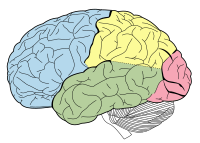
Photo from wikipedia
That symptoms play a vital role for people’s well-being is well established. Not only do symptoms signal that something is wrong but they can also predict re-admission and mortality among… Click to show full abstract
That symptoms play a vital role for people’s well-being is well established. Not only do symptoms signal that something is wrong but they can also predict re-admission and mortality among patients with myocardial infarction1,2 as well as functional status among patients with cancer.3 Moreover, symptoms predict long-term survival better than clinical signs after chronic heart failure (CHF)4 and depressive symptoms increase the risk of being affected by myocardial infarction.5 Symptoms are defined as subjective experiences of illness.6,7 When a symptom is experienced, body awareness is altered and a function that has previously been automatic is now brought to attention requiring conscious effort. The habitual equilibrium has been disturbed, which is interpreted as a bodily message.8,9 How symptoms are perceived and a person’s response to them is based on their reality6 and includes physiological, psychological, behavioural and sociocultural components.10 An effort to capture this broader view on symptoms is the basis of the biopsychosocial approach: psychological and social factors influence the illness experience and, by extension, how individuals experience their symptoms.11,12 It is not uncommon for symptoms to appear in clusters, clusters that trigger and reinforce each other.13,14 In contrast to symptoms, signs are defined as biological changes caused by disease and possible to identify and see through different procedures (e.g. imaging, biomarkers and x-ray). Signs are seen as objective and therefore viewed as more reliable to establish a diagnosis than symptoms, which can only be identified through patients’ narratives.6,7,15 The current predominant theoretical framework assumes that symptoms are signals of basic underlying disordered somatic processes (i.e. measurable or not yet measurable signs).7,16 This view is held by many despite the apparent difficulty in determining the link between biological factors and symptoms.4,17 Physicians and registered nurses (RNs) have a different but overlapping focus in their clinical assessment. Physicians are trained to assess different objective markers of disease (such as biomarkers, imaging and x-ray) and diagnose and prescribe treatment.18 In the current paradigm the primary task of the physician is to decode the patients’ symptoms to their biological referents to diagnose a disease entity.7,16 For their help they have symptom sorters to guide them to the most likely diagnosis.19 In contrast to this are disease severity and pathophysiological changes that are often poorly correlated with the suffering caused by symptoms.4,17 In CHF, for instance, a low ejection fraction is not related to quality of life (QoL) or severity of symptoms.20 RNs, on the other hand, prefer to centre on patients’ subjective experiences: illness and how it affects well-being and daily life. These different views are probably related to the content in the respective professional education and research traditions and have sometimes led to an unfortunate polarisation between physicians and RNs. Such mutual opposition is detrimental to care and is likely to cause some conflict within the professional team. Neither profession has the Person-centred care in clinical assessment
Journal Title: European Journal of Cardiovascular Nursing
Year Published: 2018
Link to full text (if available)
Share on Social Media: Sign Up to like & get
recommendations!